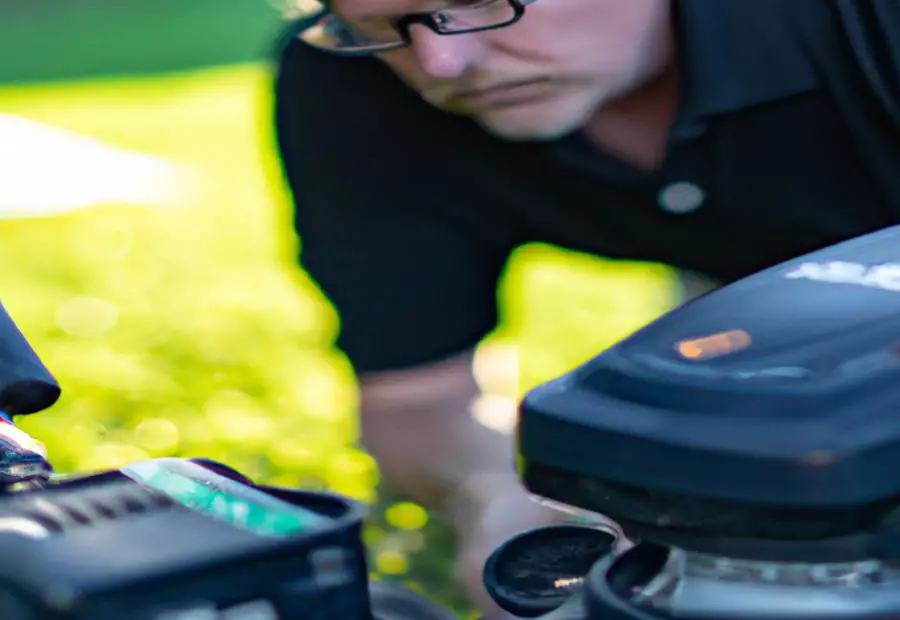GardenerHeaven.com is reader-supported. When you buy through links on our site, we may earn an affiliate commission.

When your lawn mower starts backfiring, diagnosing and fixing it can be frustrating. In this section, we’ll explore the possible causes of lawn mower backfiring and equip you with the knowledge to address the problem effectively. Get ready to dive into the world of mechanical intricacies as we uncover what could be behind those unexpected bangs from your mower.
Understanding the Causes of Lawn Mower Backfiring

Photo Credits: Gardenerheaven.Com by Aaron Adams
Backfiring in lawnmowers can have various causes. Too much air in the combustion chamber could disrupt the fuel-air mix. It can also be delayed ignition and fuel pooling if the ignition system or carburetor is acting up. Engine timing issues and intake valves being open when fuel ignites are other causes.
To diagnose the issue, check the fuel filters and pumps. Clogged or broken filters can restrict fuel flow, and faulty pumps can disrupt delivery. Do an engine tune-up to inspect and adjust components. Check the spark plugs, too – worn or dirty ones can affect ignition.
To fix the problem, replace old filters for unobstructed fuel flow. Repair faulty pumps, adjust engine timing, and clean/replace spark plugs. Keep the fuel filter clean and replace it regularly.
If backfiring happens during starting, it may be a broken flywheel. Seek professional repair to fix it.
To prevent backfiring during shut-off, reduce engine speed gradually instead of turning it off immediately. Increase airflow to the engine by keeping vents clear.
Fuel-related causes
Too much air in the combustion chamber can cause lawn mower backfiring. Delayed ignition and fuel pooling are also culprits. Identifying these fuel-related causes is critical for diagnosing and fixing the issue.
Checking fuel filters and fuel pumps reveals any potential problems. An engine tune-up helps evaluate various components that impact the fuel system. Examining spark plugs gives insights into ignition issues.
Address these fuel-related causes promptly and accurately. Replace old fuel filters for a continuous supply of clean gasoline—repair failing fuel pumps for proper fuel pressure. Restore correct timing settings for ignition to occur at the right time. Clean or replace spark plugs to prevent misfires. Keep the fuel filter clean to avoid debris entering the combustion chamber.
Knowing and addressing the fuel-related causes of lawn mower backfiring is key. Following the recommended steps and seeking professional help can minimize backfire issues, and lawnmowers can run smoothly.
Engine-related causes
Diagnosing engine-related backfiring? Check fuel filters and fuel pumps! Clogged or faulty filters can restrict flow, leading to improper combustion. Malfunctioning pumps mean insufficient fuel for the engine, causing irregularities that trigger backfiring. An engine tune-up is essential, too: inspect spark plugs, wires, and carburetors. Unique details must be considered, too: engine components, exhaust system leaks, blockages, and electrical system issues.
Example: A lawn mower owner noticed backfiring. After inspection, the spark plugs were ok. Professional help was needed: incorrect engine timing was the problem. Adjustments were made, and the backfiring was completely resolved. This shows how seeking expert help is key for engine-related backfiring!
Diagnosing the Issue

Photo Credits: Gardenerheaven.Com by Carl Nguyen
When your lawn mower starts backfiring, diagnosing the issue becomes crucial. This section will explore the steps to pinpoint the problem and get your mower running smoothly again. We’ll discuss checking fuel filters and pumps, performing an engine tune-up, and examining spark plugs to address the backfiring issue. By following these steps, you’ll know how to identify and fix the problem efficiently. Let’s dive in and get your mower back on track.
Checking fuel filters and fuel pumps
This is a 5-step guide for checking fuel filters and fuel pumps:
- Find the fuel filter. It’s usually near the carburetor or fuel tank. Carefully remove it and remember the orientation.
- Check for clogging or damage. A clogged filter can restrict fuel flow and cause backfiring. Replace if needed.
- Assess the fuel pump, making sure it’s mounted, and connections are tight.
- Test the pump by disconnecting the fuel line from either side and cranking the engine. Fuel should flow freely. If there’s no flow, the pump needs replacing.
- Reconnect all components and securely start the mower. Monitor for backfiring.
It’s essential to check and maintain fuel filters and pumps to stop backfiring. A tale: A lawn mower was backfiring. The owner adjusted the carburetor and spark plugs, but the problem stayed. Professional help revealed the fuel filter was clogged. Replacing it and ensuring the fuel pump worked solved the issue.
Regular engine tune-ups are like giving your mower a spa day.
Performing an engine tune-up
- Keep your lawn mower running at its best with an engine tune-up. To do this, check fuel filters and pumps, inspect spark plugs, adjust timing settings, and keep the fuel filter clean and replace it regularly.
- Start with fuel filters and pumps. Clogged or broken filters can stop fuel from going to the engine and cause backfiring. Replace or repair any broken ones.
- Then, take a look at the spark plugs. Faulty sparks can cause backfiring due to delayed ignition and lousy combustion. Clean or replace them.
- Correct engine timing is also essential. Incorrect settings may cause backfiring. Check and adjust based on your lawn mower’s specs.
- To avoid backfiring, maintain a clean fuel filter and replace it often. This helps with proper fuel flow and keeps combustion chambers free of air.
- If unsure, refer to your manual or get help from a pro. Tip: Use high-quality gasoline with no alcohol for optimal performance and fewer backfires.
Examining spark plugs
Spark plugs are vital in lawn mower engines’ combustion process. Examining spark plugs can help spot possible causes of backfiring.
Three aspects must be considered to check spark plugs: the color of the electrode and insulator, deposits or corrosion, and the gap between electrodes. These can offer insights into the spark plug’s health and performance.
| Factors | Significance |
| Color | Affects the ability to generate a strong spark. |
| Deposits/Corrosion | Must be within given limits for optimal performance. Incorrect gaps can lead to misfires or weak sparks. |
| Gap | Must be within given limits for optimal performance. Incorrect gap can lead to misfires or weak sparks. |
One can determine if spark plug issues are causing backfiring by assessing these. Inspecting and maintaining spark plugs is key for proper engine functioning.
Therefore, examining spark plugs is essential to diagnose and fix backfire problems in lawnmowers. It helps recognize any spark plug issues that might be causing improper fuel combustion and backfiring. To maintain optimal engine performance and prevent future backfire issues, timely spark plug replacements and regular maintenance are necessary.
Fixing the Backfire Problem

Photo Credits: Gardenerheaven.Com by Justin Lee
Fixing the backfire problem in your lawn mower involves various troubleshooting steps. From replacing old fuel filters and repairing failing fuel pumps to restoring correct timing settings, cleaning or replacing spark plugs, and keeping the fuel filter clean and replacing it regularly, this section provides practical solutions to diagnose and fix the issue effectively. By following these steps, you’ll ensure your lawn mower runs smoothly without any backfire interruptions.
Replacing old fuel filters
Tim was a true lawn enthusiast facing frequent backfiring with his old mower. After some online research, he inspected and replaced the fuel filter himself. He located it in the fuel system, removed components blocking access, and disconnected hoses or fittings connected to the filter. Then, he noted how the old filter was positioned before taking it out and installing the new one. After securely putting the new filter in its housing and reconnecting any hoses or fittings, Tim noticed an immediate improvement in his mower’s performance. No more backfiring! Tim had successfully replaced the fuel filter and enjoyed smooth, efficient mowing.
This experience reinforced the importance of regularly maintaining and replacing fuel filters for optimal lawn mower performance. Fixing a failing fuel pump is like giving your lawn mower a heart transplant, so I hope it’s covered by warranty!
Repairing failing fuel pumps
To repair a faulty fuel pump, try these three steps:
- Check Fuel Filters – Look for clogs or damage. A clogged filter can stop fuel from reaching the engine, leading to backfires. Replace the filter if it’s dirty or broken.
- Repair Fuel Pumps – Check for malfunctions or defects. Failing pumps may not deliver enough fuel, causing backfires. Repair or replace the pump if needed.
- Keep Fuel Filter Clean – After fixing the pump, keep it working correctly. Regularly check and clean the filter to avoid clogs and ensure clean fuel gets to the engine.
Following these steps, you can fix backfires caused by inadequate lawnmower fuel delivery.
It’s critical to address backfire issues and get help from experts for a well-functioning lawnmower. Ignoring backfires can cause more damage and more expensive repairs. If unsure how to repair the fuel pump, or anything else, call a technician to diagnose and fix the problem.
Restoring correct timing settings
To restore correct timing settings, follow these steps:
- Identify the manufacturer’s specifications for the mower’s timing.
- Find the flywheel and remove any debris or obstructions.
- Use a timing light to check if the timing matches the manufacturer’s specs.
- Loosen and adjust the ignition coil to reach the correct timing if needed.
- After adjustments, use the light to recheck the timing.
- Tighten parts and secure everything before using the mower again.
Refer to the manufacturer’s specs for accurate adjustments. Inspecting other engine operation components, such as spark plugs or fuel filters, may also be necessary. This helps with maintenance and improves performance.
Cleaning or replacing spark plugs
Spark plugs are an essential part of a lawn mower engine. Clean them or replace them when needed for optimal performance. Neglecting this maintenance can lead to backfiring. Cleaning or replacing spark plugs regularly is essential to keep your lawn mower running smoothly and avoid issues.
Here is a guide to effectively clean or replace spark plugs:
- Disconnect the spark plug wire from the engine to prevent accidental ignition.
- Locate the spark plugs connected by thick insulated wires near the top of the engine cylinder head.
- Use a brush or compressed air to remove dirt, debris, or carbon buildup around the spark plug.
- Check for signs of wear, damage, or excessive carbon buildup on the spark plug’s tip. Replace if needed.
- According to the manufacturer’s specs, a feeler gauge adjusts the gap between the center and ground electrodes.
- Insert the spark plug into its socket and tighten it with a wrench.
Following these steps, you can easily clean or replace your lawn mower spark plugs. Regular cleaning or replacements help maintain proper combustion in the engine and reduce backfires. Keeping spark plugs in good condition ensures efficient fuel burn and reliable performance.
Keeping the fuel filter clean and replacing it regularly
Here are six steps for keeping the fuel filter clean and replacing it regularly:
- Locate the filter between the tank and the carburetor.
- Shut off the engine and let it cool.
- Disconnect the fuel lines with a wrench or pliers.
- Carefully remove the old filter and discard it.
- Insert the new filter, making sure it is in place.
- Reattach the fuel lines securely.
Maintaining and replacing the fuel filter stops debris and contaminants from getting into the engine, which can cause backfiring.
Addressing Backfires During Starting

Photo Credits: Gardenerheaven.Com by Daniel Rivera
You’ll want to take critical steps when addressing backfires while starting your lawn mower. First, we’ll discuss the importance of checking for a broken flywheel, as this can often be the culprit behind backfiring issues. Then, we’ll explore the option of seeking professional repair for a damaged flywheel, providing some insights into why this may be necessary. By understanding these sub-sections, you’ll be well-equipped to diagnose and fix backfiring problems with your lawn mower.
Checking for a broken flywheel
A broken flywheel can be detected by conducting a thorough inspection. This part, essential for engine performance, may be damaged due to various causes like wear and tear or improper maintenance.
Here is a 4-step guide to identifying a broken flywheel:
- Check it visually: Look for any visible signs of damage, such as cracks or fractures. Pay attention to the edges and hub of the flywheel, where breakages are likely.
- Do a manual check: Gently turn the flywheel by hand and feel for resistance or strange noises. A broken flywheel could make grinding sounds or be difficult to rotate.
- Check for misalignment: Use a ruler to see if the surface of the flywheel is straight and aligned with other engine components. Discrepancies could indicate a broken flywheel.
- Test ignition and starting function: Observe how the engine starts and listen for abnormal sounds during ignition. A broken flywheel can interfere with ignition timing, resulting in difficulty starting the engine or firing issues.
It is recommended to seek professional help if any irregularities are noticed during the checking process. Addressing issues related to a broken flywheel is essential, as it can cause further damage if left untreated. Regular maintenance and inspection of this component can help avoid costly repairs.
Seeking professional repair for damaged flywheel
Damaged flywheels in your lawn mower need special attention. This could backfire and cause problems with the engine’s ignition system. Professional repair is the best way to diagnose and repair the flywheel to ensure it works correctly.
Experts in minor engine repair need to inspect and assess the flywheel. They can detect misalignment or damage with the right tools and knowledge. They can also suggest preventive measures for future problems.
Taking action quickly is essential to stop further damage or safety risks. Professionals have experience with different types of engines and the common issues that come with a damaged flywheel.
For an optimal shut-off, engine speed should be reduced gradually while increasing airflow to the engine. Rely on the professionals for repair and get your lawn mower working efficiently without any backfires!
Preventing Backfires During Shut-Offs

Photo Credits: Gardenerheaven.Com by Joshua Clark
There are two key techniques to consider to prevent lawn mower backfires during shut-off. First, gradually reduce the engine speed before turning off the mower. Second, optimize airflow to the engine. These strategies can help avoid backfiring issues and ensure a smooth shut-off process for your lawn mower.
Gradual reduction of engine speed
Gradually reducing the engine speed of a lawn mower is essential. It stops and backfires when turning it off.
Four steps to do this:
- Reduce the engine speed slowly by adjusting the throttle control lever or knob, usually on the handle.
- Lower the engine speed until it’s at its lowest. This lets any extra fuel in the combustion chamber burn off.
- Let the engine idle for a few moments to eliminate all residual fuel.
- Shut off the lawn mower with the ignition key or kill switch.
This prevents backfires and keeps the equipment in good condition.
Be aware that a broken flywheel can also cause backfires during starting. If you have this problem, check for a broken flywheel and get professional help.
Increasing airflow to the engine
Here’s a 6-step guide to increase the airflow to the engine:
- Clean or replace the air filter. If it’s clogged or dirty, it limits airflow and can cause backfires. Regular cleaning or replacement helps keep optimal airflow.
- Inspect and clean the carburetor. It controls the fuel-air mix in the engine. If damaged or dirty, it disrupts airflow and can cause backfiring.
- Clean the intake manifold. It carries air from the carburetor to the cylinders. Dirt or debris can block airflow, so clean it regularly.
- Clear the cooling fins. They dissipate heat, but if obstructed with debris or grass, it can stop airflow and cause overheating and backfiring.
- Adjust idle speed. Too high or too low can affect airflow and cause backfiring when shut off. Check the manual for instructions.
- Make sure the fuel tank is ventilated. Proper ventilation keeps pressure levels in check and prevents fuel vapor from reaching the engine bay. Check for blockages in the tank vent and clear them.
It’s essential to inspect and maintain the engine regularly for max airflow. Follow these steps for increased airflow and minimized backfiring when shut off.
Addressing Backfires After Shut-Off

Photo Credits: Gardenerheaven.Com by Eric Smith
After shutting off your lawn mower, are you experiencing backfires? Don’t fret! This section addresses this troublesome issue and provides practical solutions. From adjusting the carburetor and muffler to switching to lower alcohol content gas or installing anti-after-fire solenoids, we have the tips to diagnose and fix those pesky backfires. Say goodbye to the frustration and get your lawn mower running smoothly again.
Adjusting the carburetor and muffler
Here’s a crazy 4-step guide to tweak the carburetor and muffler:
- Analyze the carburetor: First, examine the carburetor for blockages or buildup. Clean or change as necessary. Then, alter the air-fuel combination screws according to the manufacturer’s directions. This will assist in getting the perfect mix of fuel and air in the combustion chamber.
- Perfect the idle speed: Next, adjust the idle speed screw to ensure the engine keeps a consistent idle without revving too high or stalling. This can help stop backfires at startup or shutdown.
- Check and clean the muffler: Take it off and inspect it for any clogs from debris or carbon buildup. Clear any obstructions using a brush or compressed air. A smooth and unrestricted exhaust flow is essential for proper combustion and can stop backfiring.
- See if there are exhaust leaks: Lastly, check the muffler and exhaust system for any cracks or leaks that may let air escape or enter too soon. Seal any gaps with high-temperature sealant or substitute damaged parts if needed.
Following these steps, you can adjust your lawn mower’s carburetor and muffler to stop backfire issues and enhance performance. Adjust the carburetor cautiously within specified limits to avoid causing more harm or decreasing engine performance. Professional help may be useful if the adjustments are complicated or require knowledge about your lawn mower model.
Switching to gas with lower alcohol content or no alcohol
Swap to gasoline with lower alcohol content or none at all. This solves backfires in lawnmowers. Alcohol in gas contributes to delayed ignition and fuel pooling. Lower or no alcohol decreases these issues.
Gas with lower alcohol content or none helps the fuel burn better and at the right time. Backfires can occur when too much air in the combustion chamber or fuel ignites while intake valves are open. Clean gas without excess alcohol can optimize the air-fuel mixture and improve proper ignition timing.
Lower or no alcohol also helps maintain engine health (Reference Data: Paragraph 6). E10, a blended fuel, harms components like fuel pumps and carburetors. Cleaner gas without much alcohol keeps these components from deteriorating, reducing backfiring.
Installation of anti-after-fire solenoids
- Install anti-after-fire solenoids in lawnmower engines to prevent backfires after shut-off.
- Disconnect the spark plug wire to ensure safety.
- Locate the carburetor and mount the solenoid.
- Connect it to the carburetor, then reconnect and secure the spark plug wire.
These solenoids regulate fuel flow and maintain proper air-to-fuel ratios. This helps reduce backfire occurrences and improves engine performance. Regular maintenance tasks like checking and cleaning spark plugs, replacing fuel filters and pumps, and tuning the engine are also essential for optimal effectiveness.
Conclusion: Importance of Promptly Addressing Backfire Issues and Seeking Professional Help

Photo Credits: Gardenerheaven.Com by Jose Nelson
Addressing backfire issues and getting professional help is key for keeping your lawn mower running well and lasting long. Backfiring can signal problems like a fuel mix issue or a faulty ignition system. Ignoring these can cause more damage and expensive repairs.
If your mower is backfiring, dealing with it quickly is essential. One cause could be an incorrect fuel mix, which can give suboptimal performance and be a safety hazard. A pro can check the mix and make sure it’s right.
Another cause may be a worn-out spark plug or a faulty ignition coil. Although some people try to fix these themselves, getting help is wise. A pro will know exactly the issue and how to sort it, preventing more backfires.
Plus, asking for help can stop other troubles from coming up. A professional inspection can spot any underlying issues and sort them out before they get worse. Pros also do maintenance and tune-ups, making future backfire problems less likely.
Backfiring can sometimes show a severe problem, like a damaged engine valve or piston. In this case, help is even more critical. Trying to fix these without the right expertise could worsen the problem and cost more to repair or require a new mower.
In summary, addressing backfire issues and professional help is essential for keeping your mower running and lasting. Ignoring backfires leads to damage and expensive repairs. By dealing with the causes and getting help, you can ensure your mower performs well and safely. Don’t forget to keep up maintenance and inspections to avoid future backfiring.
Some Facts About Lawn Mower Backfiring? Here’s How to Diagnose and Fix the Issue:
- ✅ Backfires in a lawn mower can occur during deceleration or after shutting down the engine. (Source: Team Research)
- ✅ Backfires are usually caused by factors such as rapid engine speed reduction, high alcohol content in fuel, lean carburetor adjustment, or muffler construction that induces backfire. (Source: Team Research)
- ✅ Backfiring can be prevented by lowering the engine speed gradually, using fuel with low or no alcohol, adjusting the carburetor properly, and increasing air volume to decrease engine temperature. (Source: Team Research)
- ✅ Backfires can also be caused by issues such as improper carburetor adjustment, malfunctioning anti-afterfire solenoid, or using gasoline with alcohol. (Source: Team Research)
- ✅ To fix afterfire, it is recommended to let the engine cool by idling it down, switch to a different fuel brand, adjust the carburetor properly, consult the equipment manufacturer for updated designs, and check the anti-afterfire solenoid. (Source: Team Research)
FAQs about Lawn Mower Backfiring?
Why does my lawnmower backfire?
Backfiring on a lawn mower can occur for several reasons, including a sheared flywheel key, using gasoline with higher alcohol blends, and having a carburetor running too lean or too rich. Issues with the fuel-to-air mixture can also cause it, a compromised spark plug, or a malfunctioning anti-after fire solenoid.
What is the danger of lawn mower backfiring?
While backfires generally do not harm the engine, they can damage the exhaust and engine over time if they occur frequently. Backfiring can be dangerous and irritating for the operator and the people nearby.
How can I prevent my lawn mower from backfiring?
To prevent backfiring, it is recommended to lower the engine speed gradually, use fuel with lower or no alcohol content, adjust the carburetor properly, and increase air volume to decrease engine temperature. Regular maintenance, such as checking and replacing spark plugs, air, and fuel filters, can also help prevent backfire issues.
What should I do if my lawn mower backfires when starting?
If your lawn mower backfires when starting, it may indicate a problem with the carburetor or flywheel. It is recommended to check the flywheel key for damage and, if necessary, replace it with any other damaged parts. Seeking the assistance of a technician or service center may be necessary.
Why does my riding lawn mower backfire?
Backfiring on a riding lawn mower can be caused by a fuel or ignition system malfunction, excessive speed, valve system failure, or engine overheating. It can also result from a faulty carburetor, clogged air filter, vacuum leaks, or incorrect engine speed.
What steps can I take to diagnose and fix a backfiring lawn mower?
Diagnosing and fixing a backfiring lawn mower may involve checking and maintaining components regularly, such as replacing old fuel filters, repairing failing fuel pumps, performing an engine tune-up, and cleaning or replacing the spark plug. It is important to address backfire issues promptly and seek professional help.




